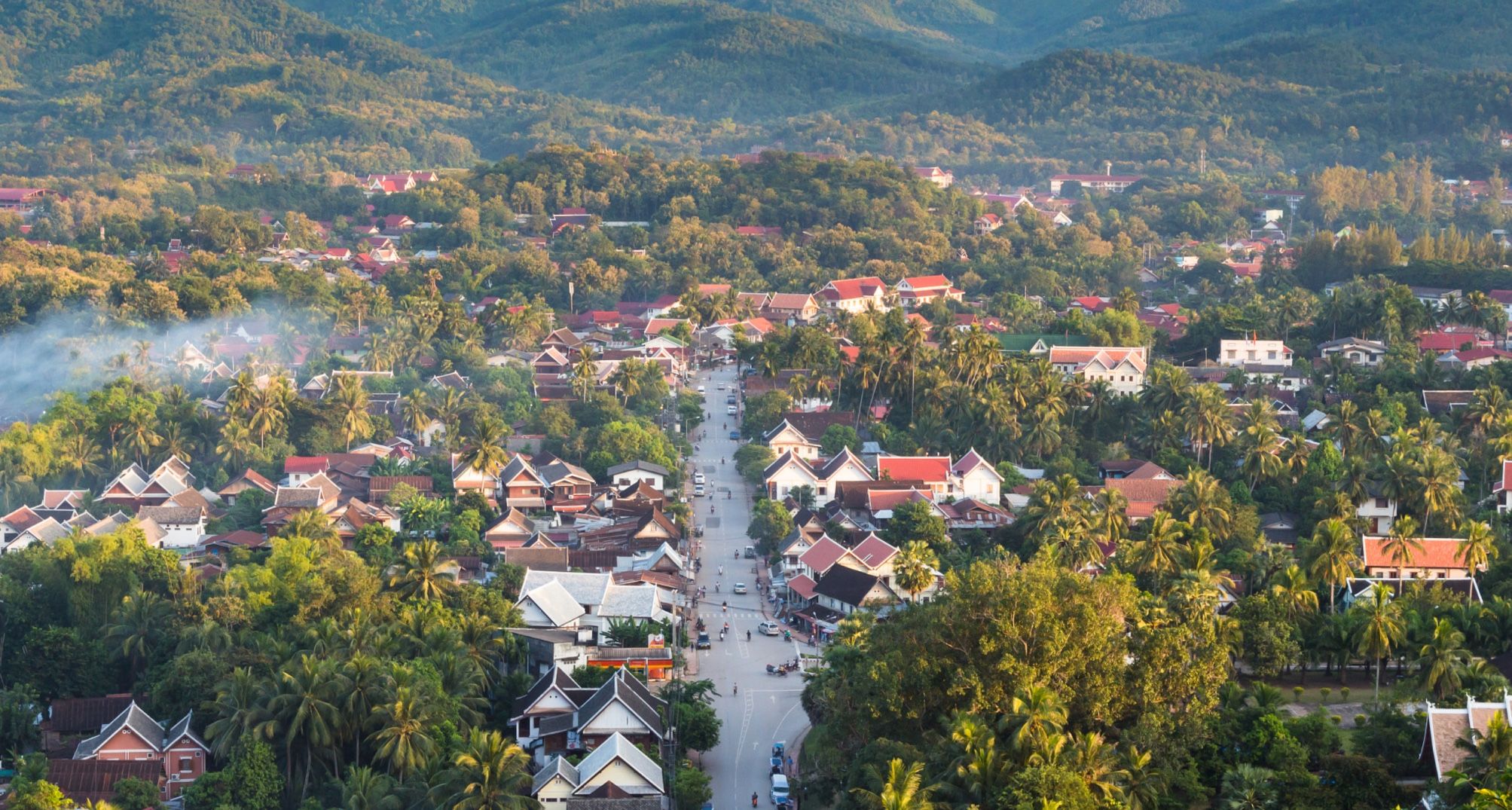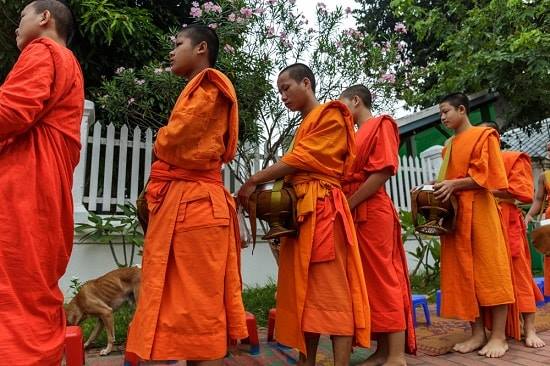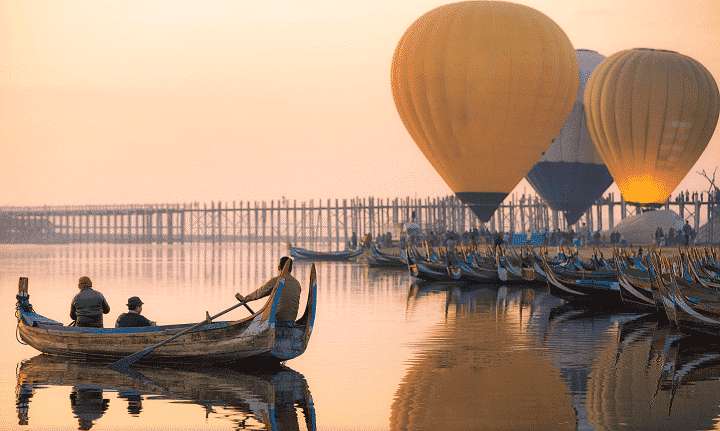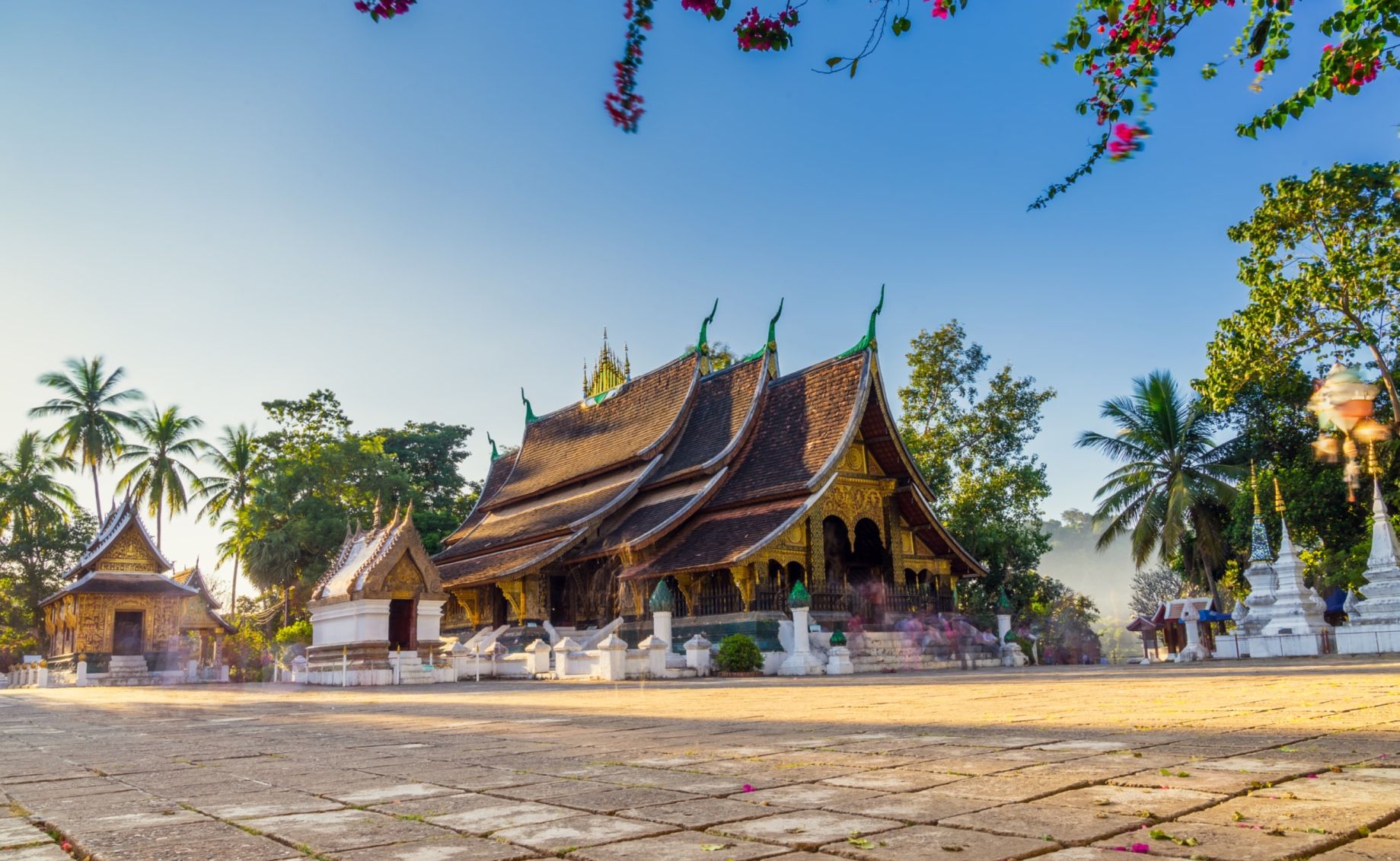23 BEST TEMPLES IN LUANG PRABANG LAOS
Buddhist Temples and Colours are two of the first elements Luang Prabang’s virtues to greet every travellers. Pearly frangipanis with their heady perfume, banks of overgrown trees peppered with scarlet flowers, the burnt sienna robes of hundreds of monks and their novices, and resplendent gold and claret wats. The scent of fresh coffee, river activity, produce markets and spicy food soon follows. And then the broader aesthetics begin to unfold. Encircled by mountains, and set 700m above sea level at the confluence of the Nam Khan (Khan River) and the Mekong River, Luang Prabang Buddhist Temples has been Laos’ foremost tourist showpiece. The brew of gleaming temple roofs, crumbling French provincial architecture and multiethnic inhabitants captivates even the most jaded travellers, and the quiet benevolence of the city’s residents lulls them into a somnambulant bliss.
Temples in Luang Prabang Laos
For centuries the best architects in Laos have focussed their attention on Buddhist temples (Wat) in Luang Prabang. Whether most famous or oldest temples in Laos, the results are most impressive in Luang Prabang where a plethora of styles and types await the interested traveller. However, it’s not only in temples that Laos has its own peculiar architectural traditions. The that (stupas) found in Laos are different to those found anywhere else in the Buddhist world. Stupas are essentially monuments built on top of a reliquary which itself was built to hold a relic of the Buddha – commonly a hair or fragment of bone. Laos has its own unique style of stupa combining hard edges and comely curves. The most famous of all Lao Buddhist temples, Stupas, or Wat is the golden Pha That Luang in Vientiane. It is the national symbol.
Planning a trip to Laos soon? Discover Laos with authentic journeys designed just for you. Best deal Tours, Hotels, Activities & Excursions. Motorbike tours across Laos and more. Book today with best Laos Tours & Holiday Packages
Wat Xieng Thong, Most famous Temple in Luang Prabang
Luang Prabang’s temple of golden city and most visited buddhist stupa located in the center of Luang Prabang, the historic Wat (Temple) is centred on a 1560 sǐm, that making it a classic of local architecture. The interior flow down to the ground and there’s a characteristic ‘tree of life’ mosaic set on its west exterior facade. Inside, gold stencil work includes dharma wheels on the ceiling and exploits from the life of legendary King Chanthaphanit on the walls. During 1887 when the Black Flag army sacked the rest of the city, Xieng Thong was one of just two temples to be (partially) spared. The Black Flag’s leader, Deo Van Tri, had studied here as a monk earlier in his life and used the desecrated temple as his headquarters during the invasion.
The Wat Xieng Thong Temple is dotted around the sǐm are several stupas and three compact little chapel halls called hŏr . Hŏr Ɖąi , shaped like a tall tomb, was originally a ‘library’ but now houses a standing Buddha. The other two sport very striking external mirror-shard mosaics depicting local Laos’s village life and the exploits of Siaw Sawat, a hero from a famous Lao novel. The Hŏr Pa Maan (‘success’ Buddha sanctuary) remains locked except during the week following Pi Mai. The Hŏr Ɖąi Pha Sai-nyàat (reclining Buddha sanctuary) was dubbed La Chapelle Rouge – Red Chapel – by the French. It contains an especially rare reclining Buddha that dates from the construction of the temple. This one-of-a-kind figure has an exquisitely sinuous upper body with a right hand seeming to gesture ‘Oh, whatever!’. The contrastingly rectilinear feet emerge on die-straight legs from beneath monastic robes that curl upward like rocket fumes.
The great temple is fronted in especially lavish gilt work, the Hóhng Kép Mîen is a garage for a ceremonial carriage designed to carry the huge golden funeral urns of the Lao royalty. This glittering vehicle is festooned with seven red-tongued naga snakes that contrast amusingly with the prosaic Bridgestone tyres of its undercarriage.
Phu Si: Top choice in Luang Prabang
Phu Si dominates the Luang Prabang’s skyline. It stands towards the middle of the peninsula formed by the confluence of the two rivers. Since it is visible from any point in town, Phu Si serves as a very helpful ‘beacon’ for orientating yourself. Most of the historic temples are located between Phu Si and the Mekong, while the trading district lies to the south of the hill. It is also known as the Mount Phousi, the Wat was constructed in early 18th century by the direct order of King Anourat, there is a 20 meter tall golden stupa sits on a narrow terrace at the top of the mountain.
Hiking up the 100m high Phu Si is possible through the 329 steps. Phu Si is crowned by a 24m Wat called That Chomsi. Reaching the stupa is also from both south and eastern sides. The 24m-high That Chomsi, erected in 1804 and restored in 1914, stands at the summit, clearly visible from most ground-level points in the city. This stupa is the starting point for a colourful Laos New Year procession in mid-April. If you continue over the Phu Si summit and start down the path on the other side, you’ll come to a small cave shrine (sometimes called Wat Tham Phu Si, although without monks it’s not officially a wat).

Wat Ho Pha Bang – Buddhist temple in Luang Prabang Laos
The Temple of Pha Bang is a 83cm tall Buddha cast of a gold, silver and bronze, and is said to weigh 53.4kg. Legend has it the image was cast around the 1st century AD in Sri Lanka and later presented to Khmer King Phaya Sirichantha, who in turn gave it to King Fa Ngum in 1359 as a Buddhist legitimiser of Lao sovereignty. A project planned before the monarchy was abolished in 1975, construction on this highly ornate pavilion began in 1993 and not finished till late 2006.
This beautiful temple built in traditional Laos style. Although the temple appears old at first glance, it is a fairly new in look and structure. The very ornate structure with extensive glass and gold decoration is set on a multi-level raised platform. Its multi-tiered roof is adorned with stylized Naga finials at the roof’s ends. At the center top of the roof is a “Dok so faa”, an ornamental element consisting of 17 spires found on many Laos temples. The very ornate wooden front façade is carved with Buddhist depictions in green and gold colors. Stairways with multi-headed mythological Naga serpents lead to the entrance, the body of the snake extending all across the balustrades.

Wat Mai Suwannaphumaham, temple in Luang Prabang
Beside the palace, Wat Mai is one of the Luang Prabang’s most sumptuous monasteries. Its wooden sǐm (ordination hall) has a five-tiered roof in archetypal Luang Prabang style, while the unusually roofed front verandah features detailed golden reliefs depicting scenes from village life, the Ramayana and Buddha’s penultimate birth.
The temple built in 1821 to replace a 1796 original, this was the mai (new) monastery. The name has stuck. It was spared destruction in 1887 by the Haw gangs who reportedly found it too beautiful to harm. Since 1894 it has been home to the Sangharat, the head of Lao Buddhism.

Wat Aham – Luang Prabang Buddhist Temple
Between Wat Wisunarat and the Nam Khan stands Wat Aham temple in Luang Prabang, which was formerly the residence of the Sangkharat (Supreme Patriarch of Lao Buddhism). Two large banyan trees grace the grounds, which are semideserted except for the occasional devotee who comes to make offerings to the town’s most important spirit shrine at the base of the trees. This small Temple in Laos’s Luang Prabang was the residence of the Sangharat until two centuries ago, when its place was taken by Wat Mai. The internal walls are decorated with simple but colorful paintings, which depict episodes from the history of Buddhism and moral tales, sometimes even horrifying. The temple may not be the business in terms of visiting, but however, is one of the most beautiful Buddhist temples in Laos.

Laos Buddhist Temple, Wat Wisunalat in Luang Prabang
Stands next to Wat Aham, the temple is originally built in 1513 during the reign of Chao Wisunarat (King Visoun), Wat Wisunarat is the oldest operating temple in Luang Prabang and one of the oldest temple in Laos. It was rebuilt between 1896 and 1898 following an 1887 fire set by Black Flag Haw raiders. The original was wooden, and in the brick and stucco restoration the builders tried to make the balustraded windows of the sǐm appear to be fashioned of lathed wood (an old South Indian and Khmer contrivance that is uncommon in Lao architecture).

Other Buddhist Temples in Luang Prabang, Laos
Wat Xieng Maen Founded in 1889 and since abandoned, Wat Tham Xieng Maen is in a 100m-deep limestone cave called Tham Sakkarin Savannakuha (a little northwest of Wat Long Khun). Many Buddha images from temples that have been torched or otherwise fallen into decay are kept here; during Bun Pi Mai Lao many local worshippers come to Wat Tham to pay homage and cleanse the images. To get here, you’ll need to cross the nam khan river and take a ferry, the temple stand alone and is surrounded with trees and lush greenery.
Phra That Khong Santi Chedi The Phra That Khong Santi Chedi, built in 1988, has become a favorite temple touring in Luang Prabang. This large yellow stupa contains three floors inside and an outside terrace near the top with a view of the surrounding plains. The inside walls are painted with all manner of Buddhist stories and moral admonitions.
Wat Chom Phet Worth a visit as one of the contemporary temples in Laos. The Wat located at the top of a hill above Wat Long Khun and Wat Tham, on the Western side of the Mekong, is peaceful Wat Chom Phet, built by the Thai army in 1888 and offering an undisturbed view of the town and river. A small thâat here contains the bones of Chao Thong Di (wife of King Sakkarin), who died in 1929.
Wat Choumkhong Wat Choumkhong is a small but very pretty temple with one of the loveliest gardens in town. In November and December it’s awash with colour courtesy of poinsettia trees.
Wat Longkhun Locally known as the Wat Rungkhum, Wat Long Khun, almost directly across the Mekong River from Wat Xieng Thong, is the best place to disembark by boat for Xieng Maen explorations if you’re chartering a boat. This wat features a nicely decorated portico, vintage 1937, plus older sections from the 18th century and a few fading Jataka murals. When the coronation of a Luang Prabang king was pending, it was customary for him to spend three days in retreat at Wat Long Khun before ascending the throne.
Wat Manorom Although its outer appearance isn’t very impressive, Wat Manolom temple stands just outside the barely visible Luang Prabang’s walls and occupies possibly the oldest temple site in Luang Prabang. City annals say it was founded in 1375 on the site of a smaller temple established by King Fa Ngum.
Wat Nong Sikhunmeuang The simple Wat Nong Sikhunmeuang temple was built in 1729, burned in 1774 and rebuilt in 1804. It is located in Luang Prabang’s old town set in a pleasant complex.
Wat Pa Huak The decaying sǐm at Wat Pa Huak – on the lower northern slope of Phu Si, near the Royal Palace Museum – has a splendid carved wood and mosaic façade showing Buddha riding Airavata, the three-headed elephant of Hindu mythology (in which he is usually depicted as Lord Indra’s mount). The gilded and carved front doors are often locked, but during the day there’s usually an attendant nearby who will open the doors for a tip of a couple of hundred kip.
Wat Pa Phai Set back off the street, Wat Pa Phai’s classic Tai-Lao fresco over the glazed and carved wooden façade is at least 100 years old temple. The picture depicts scenes from everyday Lao life from the era in which it was painted.
Wat Pa Phon Phao Located slightly out of Luang Prabang and its easily accessible by a short tuk-tuk ride. The Wat Pa Phon Phao, stands in the middle of lush forest and it has been famous for its meditation teachings of the late abbot, Ajahn Saisamut. Saisamut’s funeral in 1992 was the largest and most well attended monk’s funeral Laos had seen in decades has been in the temple.
Wat Pha Baht Tai On the Mekong River near the north-western end of Th Phu Vao is the modern Vietnamese-Lao temple Wat Pha Baht Tai. The temple itself is rather garish but behind the temple is a shady terrace overlooking the Mekong; on a hot afternoon this is a good place to cool off and watch the sunset.
Wat Pha Mahathat Wat Pha Mahathat is named for a venerable Lanna-style temple erected in 1548. The sǐm in front, built in 1910, is quite ornate, with carved wooden windows and portico, rosette-gilded pillars, exterior Jataka (stories of the Buddha’s past lives) reliefs and a roof in the Luang Prabang style lined with temple bells. The massive naga along the steps, also Lanna in style, resemble those at Wat Phra That Doi Suthep in Chiang Mai, Thailand.
Wat Pha Phutthabaht Around on the northeastern flank of Phu Si are the ruins of Wat Pha Phutthabaht, originally constructed in 1395 during the reign of Phaya Samsenthai on the site of a ‘Buddha footprint’. The ruins of the temple are of mixed style but are said to show a definite Lanna or Chiang Mai influence, as well as some later Vietnamese augmentation.
Wat Sensoukarahm In the northeastern corner of town near the meeting of the Nam Khan and the Mekong River is a string of historic, still active temples. Facing Th Sakkarin is Wat Sensoukarahm, a Thai-style wat built in 1718 and restored in 1932 and 1957. The name reportedly refers to its founding on an initial huge donation. It has one of the most dazzling facades of all of Luang Prabang’s temples; rich ruby red with intricate gold overlay.
Wat That Luang Legend has it that Wat That Luang was originally established by Ashokan missionaries from India in the 3rd century BC. However, there is no evidence whatsoever to confirm this, and the current main hall was built in 1818 under the reign of King Manthaturat.
Wat That Luang Legend has it that Wat That Luang was originally established by Ashokan missionaries from India in the 3rd century BC. However, there is no evidence whatsoever to confirm this, and the current sǐm was built in 1818 under the reign of King Manthaturat.
Wat Xieng Mouane The sǐm (ordination hall) at Wat Xieng Muan temple dates back to 1879, though the monastery site is much older. The sculpture inside is impressive and the ceiling is painted with gold nagas (mythical water serpents), an uncommon motif in this position – possibly a Thai Lü influence. Also notable is the elaborate háang thíen (candle rail) with nagas at either end.
Copyright 2013-2017 Vietnamese Private Tours Ltd With Vietnam Luxury Travel








